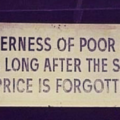Podcast: Play in new window | Download (Duration: 30:08 — 20.9MB)
Subscribe: Apple Podcasts | Google Podcasts | Spotify | Stitcher | Podchaser | Email | TuneIn | RSS
This week we talk about Software Quality vs Grade.
Definition of Quality
- PMBOK V.5 – “Quality is the degree to which a set of inherent characteristics fulfills requirements”
- PMBOK: Project Management Body of Knowlege
- ISO 9000:2015 – “Quality is the totality of features and characteristics of a product or service that bear on its ablility to satisfy stated or implied needs.”
- ISO: International Standards Organization (International Organization for Standardization)
- Put Simply – Quality is the fulfillment of the requirements.
Definition of Grade
- PMBOK V.5 – “Grade is a category or rank used to distinguish items that have the same functional use but do not share the same requirements for quality.”
- Put Simply – Grade ranks items by the strictests set of requirements they fulfill
How does this Apply to Software?
Softare Quality (in terms of meeting requirements) is a pass fail
Compare to Chemical Engineering
- Produced Various Grade’s of Polymers
- Any product could be in-spec (within specifications) or out-of-spec(outside specifications) of a given set of requrements
- Across Chemical companies, the process for creating production vary significally regardless if they are producing the same grade of product (the end user is generally uneffected)
- The processes themselves are measure and can be certified to meet certain specifications.
Stop Conflating the Source Code with the Product
- Software specifcations are (should) be written from the funtionality value that is provided to the user.
- Software should be evaluated according to the fullfillment of those requirements.
- We cannot ignore the process of creating, maintaining and changing software
Two sets of Requirements
- Software Product Requirements
- Software Process Requirements
Gold Plating
- Gold plating is simply meeting additional software product requirements that are not in scope
- We need to stop gold plating, if the changes are needed there needs to be a change of scope
- Gold plating is not following architentual and devleopment choices to ensure proper software process requirements are met
- Where does logging fit in?
Technical Debt
-
Should be only 2 kinds of Techincal Debt but…
- Intentional
- Choose to leave a software process requirement unfullfilled, in order to fulfill a product requirement more quickly, cheaply, etc
- Discovered
- Fulfillment and specification of software process requirements, create additional burden in order to fulfill a softare product requirement
- (Unfortunate Third) Unintentional
- Poor fullilment of software process requirements either because of lack of understanding, specification, or negligence
- Intentional
-
Tech Debt is a lot like real debt in that it costs interest while it exists
-
So might choose to take on tech debt to more quickly produce a feature, however, until its “paid off” every new change will cost itself plus the additional interest of the debt
-
This snoballs when the business does not want to pay the cost+interest of the next feature and looks to use more debt to reduce that cost
-
Discovered Technical Debt is reduced by following good design patterns and practices, like, SOLID and TDD as they tend to leave the code easier to change.
Links
http://www.maxwideman.com/papers/quality/academic.htm
https://www.projectengineer.net/project-quality-management-according-to-the-pmbok/
http://www.fao.org/3/w7295e/w7295e03.htm
https://www.iso.org/obp/ui/#iso:std:iso:9000:ed-4:v1:en
“Tempting Time” by Animals As Leaders used with permissions – All Rights Reserved
An International Speaker, Author, and Microsoft MVP, John has been a professional developer since 1999. He has focused primarily on web technologies and currently focuses on C# and .NET Core in Azure. Clean code and professionalism are particularly important to him, as well as mentoring and teaching others what he has learned along the way.









